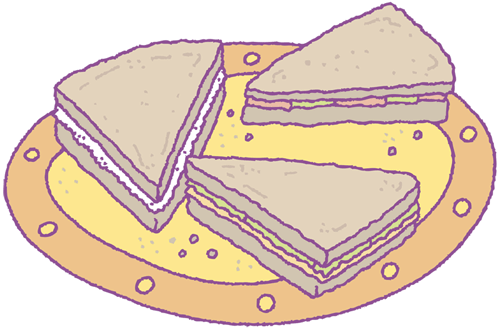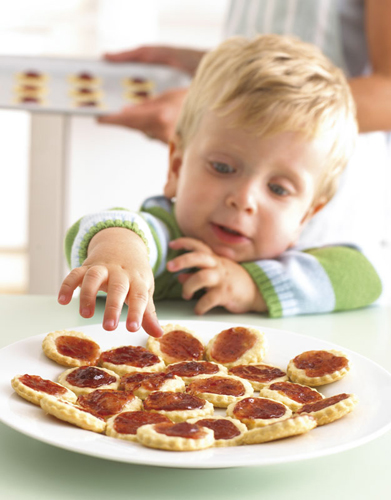Snacks and treats don’t have to be unhealthy to be tempting and delicious, and with the right ingredients, they can form a nutritious and integral part of your child’s well-balanced diet. Used judiciously, too, they add important variety to your child’s diet, and encourage little ones to experiment with a wider range of flavors.
| Q: |
How important are snacks? My child simply can’t make it between meals without something to eat.
| | A: |
Snacks can be very important for some toddlers who will struggle
to make it between main meals without something to eat. The reason is
that their tummies are small, and they can’t get adequate calories in
one sitting to see them through long periods without something to eat.
They all need some refueling, and it is healthy to encourage them to eat
when they are hungry, so that they learn to understand and respond to
“hunger cues.” Many children with weight problems never experience the
feeling of being hungry, and are encouraged to eat constantly, and to
clean their plates. You’ll be doing your toddler a favor by allowing her
to pick and choose from a snack plate, and to eat according to her own
needs.
The secret is to
schedule your snacks so that they don’t run too close to mealtimes
(which can be counterproductive, as your toddler won’t be hungry enough
to eat properly, and will demand more snacks afterward), to offer
healthy food that doesn’t detract from the nutritional value of her
overall diet (see More snack ideas), and to avoid “grazing” (a constant succession of snacks between meals).
|
| Q: |
Should I allow my child to help himself to snacks when he is hungry?
| | A: |
Yes, and no. Most certainly allow him to choose from a selection
of snacks at the appropriate time, but make sure you give a choice of
things that you actually want him to eat.
Helping himself whenever
he is hungry, however, is not a good idea. First of all, it can lead to
unhealthy grazing, which means that he won’t have an appetite for meals,
and it can also lead to overeating—choosing food for comfort, or eating
when he’s actually thirsty rather than hungry.
It’s good practice
to allow older kids to choose one or two snacks from a “healthy” snack
drawer or shelf in the fridge, during pre-arranged times, as it
encourages them to make healthy choices and to eat only when they are
hungry. Toddlers, however, do not have the maturity to make sensible
choices, and won’t understand that a little might be enough to satisfy
them.
|
| Q: |
Does excess sugar make it harder for my child to sleep?
| | A: |
Most definitely. First of all, sugar causes a “blood sugar” rush,
which means that she will experience a burst of energy (appearing
hyperactive, even), followed by a slump, which leaves her tearful,
tired, and even withdrawn. So sugary foods eaten near to bedtime will
discourage settling down to sleep; however, if she’s had them a couple
of hours in advance, she may collapse into bed in exhaustion. But that
doesn’t mean that offering sugary foods is a good way to ensure sleep
later on. High sugar intake can cause restless sleep, as your child’s
body struggles to adjust the insulin required to deal with what she’s
eaten.
|
| Q: |
At what age can I offer sweets?
| | A: |
The longer you leave it, the better, as you will put off the
inevitable demands that occur from the minute your toddler has her first
taste! It’s important to remember that toddlers have small tummies, and
even a tiny packet of sweets can fill them up with empty calories, and
prevent them from eating a healthy meal or snack. Sweets also cause
tooth decay, which can affect even milk teeth.
There is no real
reason why sweets of any nature need to be introduced before the age of
two. However, once your toddler starts nursery school or playgroup, or
spends time with other children on play dates or in day care, he may not
agree! Peer pressure occurs in even the tiniest tots, and most kids
want to eat what their friends are eating.
There is no reason why
you have to give in, and you can most certainly explain why you don’t
want your toddler to eat certain foods, but the day of reckoning is on
the horizon and he’ll undoubtedly have his first tastes soon. For this
reason, it’s a good idea to introduce them yourself, first, and to
establish your family view on sweets. Some families have a “sweet” jar,
and allow one after dinner on the weekend, perhaps, which gives a little
one something to look forward to, and also makes it clear that they
aren’t “everyday’” foods. Similarly, bake a treat together, such as jam tarts,
and impress the idea that this is a special treat. You can also offer
some healthier alternatives to sweets, such as yogurt-covered raisins or
dried fruit pieces in child-friendly packets.
Make treats occasional.
Diets high in sugar are also often high in fat and low in fiber. If
your child fills up on sugary and fatty foods, he is likely to be at
risk of vitamin and mineral deficiencies and at risk of obesity, heart
disease, and diabetes in later life.
|
More snack ideas
Breadsticks with cream cheese Rice cakes or a little dried cereal Fromage frais Chunks of cheese Dried fruit Toasted pita bread with hummus
Smoothies
Fresh fruits and vegetables with dips Fruit popsicles Fresh muffins Mini-sandwiches (see Sandwiches for Toddlers Bread with a little butter
Sandwiches for Toddlers
You can add more texture
for this age group, but not too many chunks. Flatten the slices of
bread with a rolling pin before buttering them lightly—thinner
sandwiches are easier for toddlers to hold and eat.

Egg and Chive Sandwich
Lower 1 egg into a
saucepan of boiling water and simmer for 12 minutes. Immediately rinse
with plenty of cold water, then peel off the shell. Mash the egg with 2
tsp mayonnaise, 2–3 snipped fresh chives, and a little seasoning. Use to
fill one or more sandwiches.
Double Cheese Sandwich
Spread cream cheese over
one slice of bread and scatter 1/4 cup shredded Cheddar cheese over the
top. Top with the second slice of bread.
Peanut Butter-banana Sandwich
Spread 1 tbsp peanut
butter (smooth or crunchy) over one slice of bread, then top with 1/2
small mashed banana. Add the second slice of bread.
Salmon and Tomato Sandwich
Mash some drained
canned salmon over one slice of bread (be sure to remove any bones) and
spread with 1–2 tsp ketchup. Top with the second slice of bread.
Cottage Cheese-pineapple Sandwich
Scoop this from a tub and use to fill a sandwich.
Mini-jam Tarts
It’s fun for children to make mini-treats like jam tarts since they can be involved in the whole process: making the pastry, rolling it out, cutting the circles and pushing them into tins, and spooning in the jam. For a richer pastry, add an egg yolk and use less water.

30 minutes plus 1 hour resting
12–15 minutes
12/3 cups all-purpose flour, plus extra for rolling 1/2 cup butter, diced Pinch of salt 2–3 tbsp ice water 1/2 cup high-fruit strawberry spread with no added sugar
Put the flour and salt
in a bowl, add the butter, and rub in with your fingertips until the
mixture looks like fine bread crumbs. Add 2 tbsp water and stir with a
metal spatula, adding more water a little at a time until the mixture
will just hold together without crumbling when squeezed lightly. Flatten
the dough into a disk. If possible, wrap in plastic wrap and
refrigerate for 1 hour.
Preheat the oven to
400°F. Roll out the dough on a lightly floured surface until thin (about
1/8 inch) and cut out about 24 circles with a 21/2-inch fluted round
cutter. Gather up the trimmings and reroll as necessary. Carefully press
the dough circles into a 24-hole mini-cupcake or mini-muffin tin.
Put scant 1 tsp of
strawberry spread in each pastry shell. Bake until the pastry is
golden, 12–15 minutes. Let cool in the tins for 5 minutes, then transfer
the tarts to a wire rack to cool completely. Store in an airtight
container.
To freeze, put the
cooled tarts in a single layer in a resealable box and freeze; when
needed, thaw at room temperature for 1–2 hours.
|